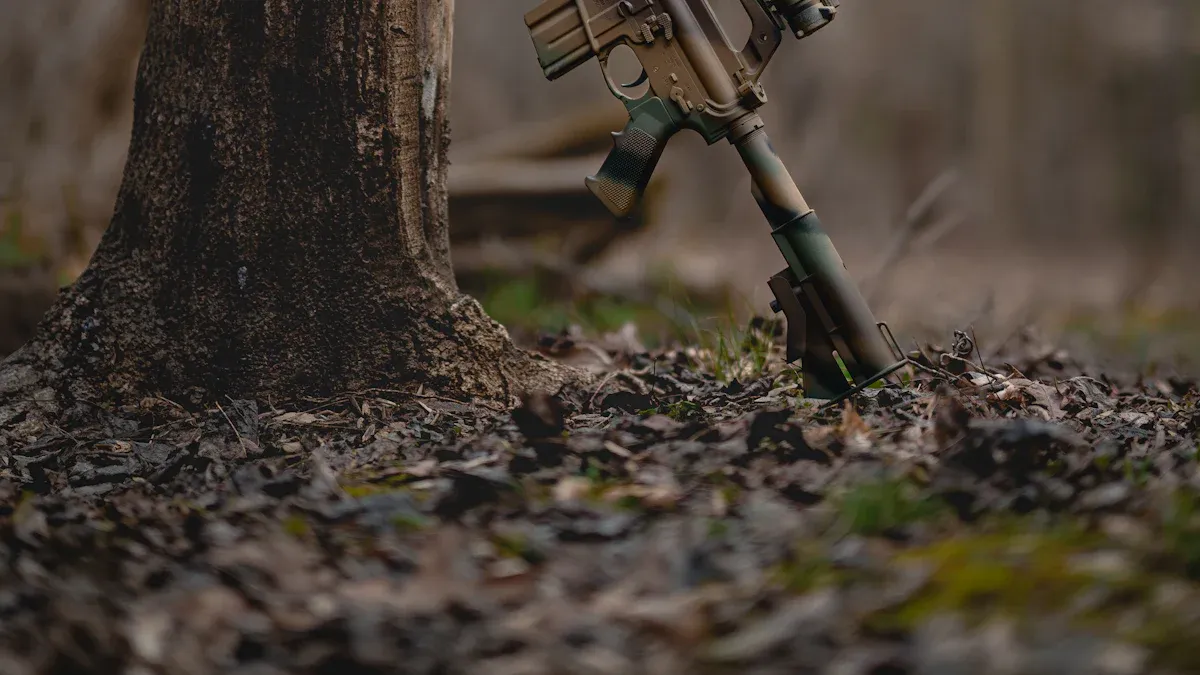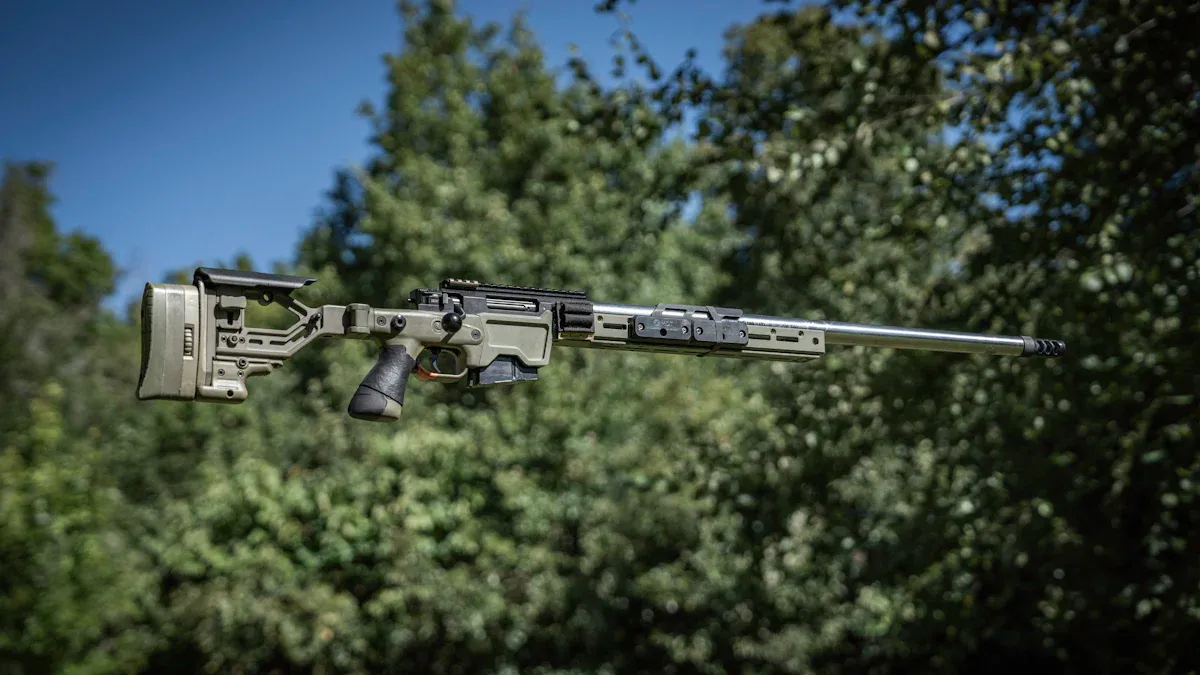
Selecting the right rifle bipod transforms a hunter’s experience, especially in challenging terrains. Stability plays a key role in accuracy, particularly at longer distances. Many shooters report improved precision when using a rifle bipod, as it minimizes movement and enhances control. A proper setup, including a reliable mount and compatible rifle scope accessories, ensures comfort and confidence. For instance, hunters often feel more stable and achieve greater success when shooting beyond 400 yards with a rifle bipod. Whether on flat ground or rugged terrain, the right bipod adapts to the environment, helping hunters maintain consistent body positioning and focus on their target while utilizing the rail for additional support.
Key Takeaways
- Pick a bipod that fits the ground type. On flat land, use even leg lengths for better balance. For rocky spots, choose adjustable legs and rubber feet for grip.
- Check if the bipod’s height can change. This helps you switch positions easily, making shooting more comfortable and precise.
- Take care of your bipod often. Clean it after using and oil the moving parts to keep it working well.
Terrain Considerations for Rifle Bipods

Choosing a Bipod for Flat Ground
Flat ground offers an ideal surface for using a rifle bipod. Stability improves significantly when the bipod is properly set up. Hunters often find that bipods enhance accuracy on hard surfaces, especially during long-distance shots. However, common mistakes, such as uneven leg extension or ignoring environmental factors, can reduce performance. Regular maintenance ensures the bipod remains reliable in these conditions.
To maximize stability, hunters should adjust the bipod legs evenly and ensure the rifle sits level. Hard surfaces provide excellent support, but slight bouncing may occur after firing. This can be minimized by using a bipod with shock-absorbing features. A well-maintained bipod allows hunters to focus on their target without worrying about unnecessary movement.
Adapting to Uneven or Rocky Terrain
Uneven or rocky terrain presents unique challenges for hunters. A high-quality rifle bipod designed for adaptability can make a significant difference. Features like swivel adjustments and rubber feet improve grip and stability on uneven surfaces. Longer legs help clear obstacles, but they may introduce slight flex, which can affect accuracy.
Hunters often prefer bipods with adjustable leg lengths and durable materials for rocky environments. These features allow for quick adjustments, ensuring the rifle remains steady despite the terrain. While some shooters find sandbags more effective in such conditions, a well-designed bipod can provide the necessary stability for accurate shots.
Stability in Wet or Muddy Conditions
Wet or muddy conditions demand a rifle bipod that can maintain stability without sinking into the ground. Soft ground often causes the bipod to sink, altering the rifle’s angle and affecting shot placement. To counter this, hunters should look for bipods with wide, flat feet or specialized attachments designed for soft terrain.
Rubberized feet provide better grip in slippery conditions, preventing the rifle from sliding. Regular cleaning and maintenance are crucial after exposure to mud or water to ensure the bipod remains functional. A reliable bipod helps hunters stay focused, even in challenging weather.
Key Features of a Rifle Bipod
Importance of Height Adjustability
Height adjustability transforms the shooting experience, allowing hunters to adapt to different scenarios with ease. Adjustable legs enable shooters to set the rifle at the perfect height, ensuring comfort and stability. This feature proves invaluable when shooting from unconventional positions, such as wearing body armor or using modern sporting rifles. Taller bipods provide the flexibility needed for these situations, helping hunters maintain focus and precision.
Independently adjustable legs further enhance adaptability, especially on uneven terrain. Shooters can stabilize their rifles in almost any location, whether on rocky ground or soft soil. This versatility ensures consistent accuracy, regardless of the environment. By choosing a bipod with reliable height adjustability, hunters can elevate their performance and enjoy greater success in the field.
Comparing Mounting Options
Mounting options play a crucial role in the functionality of a rifle bipod. Different systems cater to various rifle types and user preferences. For example, Picatinny rail mounts offer quick-release mechanisms, making them ideal for hunters who need to switch setups rapidly. Lever mounts, such as the ARMS 17S, provide secure attachment and compatibility with a wide range of rifles.
Other mounting systems include direct Keymod attachments and Harris mounts, which work with Keymod rails, M-Lok rails, sling swivels, and even shotguns. These options allow hunters to customize their bipods to match their rifles and shooting styles. Selecting the right mounting system ensures a seamless connection between the rifle and bipod, enhancing stability and accuracy.
Balancing Weight and Portability
Weight and portability determine how practical a rifle bipod is for hunting. Heavier bipods suit larger caliber rifles, as they help manage recoil effectively. On the other hand, lightweight bipods are ideal for smaller rifles, offering portability without compromising stability.
Hunters often seek a balance between weight and robustness. Lightweight models like the MDT Ckye-Pods provide excellent stability while reducing the overall weight of the rifle setup. For prone shooting, bipods with legs extending 6 to 8 inches strike the perfect balance between height and usability. Longer legs may add weight and flex, but they offer greater adaptability for challenging terrains. By considering weight and portability, hunters can select a bipod that complements their rifle and enhances their shooting experience.
Types of Rifle Bipods for Hunting

Best Hunting Bipods for Versatility
Hunters often seek bipods that can adapt to various terrains and shooting positions. Versatile bipods excel in hilly or mountainous environments, where prone shooting may not be possible. Models with adjustable heights, ranging from 14 to 30 inches, allow hunters to shoot comfortably while sitting or kneeling. These bipods provide stability for long-distance shots, even on uneven ground.
| Feature | Details |
|---|---|
| Height Range | 14 – 30 inches, ideal for sitting or kneeling positions |
| Use Case | Perfect for hilly or mountainous environments |
| Stability | Allows stable shots over long distances |
Many hunters favor bipods with quick deployment and durable designs. For example, the Harris bipod is popular for its reliability and ease of use. However, some versatile models may come at a higher price, making them an investment for serious hunters.
Benchrest Bipods for Precision Shooting
Benchrest bipods are designed for shooters who prioritize accuracy. These bipods provide a stable platform for precision shooting, especially during target practice or competitions. They often feature adjustable legs and panning capabilities, allowing shooters to fine-tune their aim.
Hunters using benchrest bipods benefit from their sturdy construction and ability to handle heavy rifles. While these bipods excel on flat surfaces, they may lack the adaptability needed for rugged terrains. Shooters looking for pinpoint accuracy often find these bipods indispensable for their setup.
Two-Part Systems for Advanced Adaptability
Two-part bipod systems offer unmatched flexibility for hunters navigating diverse terrains. These systems typically include a detachable base and adjustable legs, allowing for quick customization. Hunters can switch between prone, sitting, or kneeling positions with ease.
| Feature | Details |
|---|---|
| Multi-Use Bipods | Built into forward grips, suitable for tactical rifles |
| Stability | Less stable than traditional bipods, but affordable for close quarters |
| Height Adjustment | Typically do not have adjustable height or independent legs |
While two-part systems may lack the stability of traditional bipods, they shine in situations requiring rapid adjustments. Hunters in tall grass or uneven environments often appreciate the adaptability these systems provide.
Choosing the right rifle bipod requires careful consideration of terrain, features, and budget. Hunters benefit from advancements in materials and design, which enhance performance across diverse conditions. Bipods like Harris and Atlas dominate the market due to their reliability. Prioritizing stability and adaptability ensures hunters achieve greater accuracy and success in the field.
FAQ
What is the best way to maintain a rifle bipod?
Regular cleaning prevents dirt buildup. Lubricate moving parts to ensure smooth operation. Inspect for wear and replace damaged components promptly.
Can a rifle bipod improve accuracy in all terrains?
Yes, a rifle bipod enhances stability, reducing movement. Features like adjustable legs and rubber feet adapt to various terrains for consistent accuracy.
How do I choose the right rifle bipod for my hunting style?
Consider terrain, rifle type, and shooting position. Look for features like height adjustability, portability, and mounting compatibility to match your needs.
Post time: Mar-31-2025
